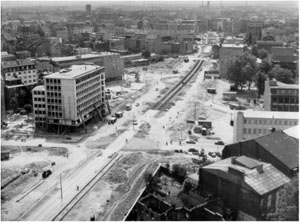2. Berliner Allee as the new north-south axis
The corner of Berliner Allee and Steinstraße in the late 1950s
 Click image to enlarge
Click image to enlarge
Source: photographer unknown, date unknown, Traffic Management Department of the state capital Düsseldorf.
Corneliusstraße before the introduction of trams
 Click image to enlarge
Click image to enlarge
Source: photographer unknown, date unknown, Traffic Management Department of the state capital Düsseldorf.
Questions
Answers
- Gaps between buildings were closed, design and lay-out of roads were well-planned, which leads to high congestion, street car tracks are used as parking lots.
- In built-up areas there is higher pollution, as well noise as contamination loads. The street becomes a main road.
- Reducing the parking space in the inner part of the city, developing the local public transportation, measures to reduce the risk of traffic jams: “green wave”; recently: promoting low-emission cars, low-emission zones.




Presentation
The destruction of WWII enabled new ways of handling the traffic. The demolition of the blocks made it possible to broaden the north-south axis and to add the tramway. Nowadays the street is a built-up area.